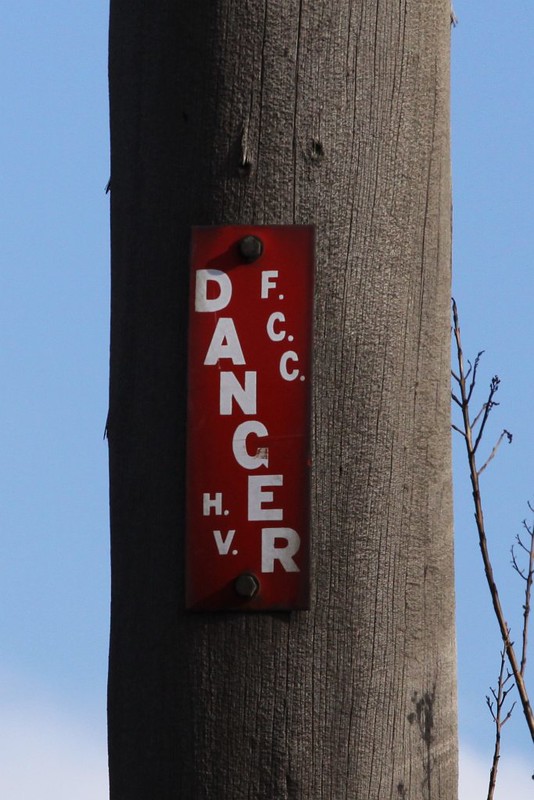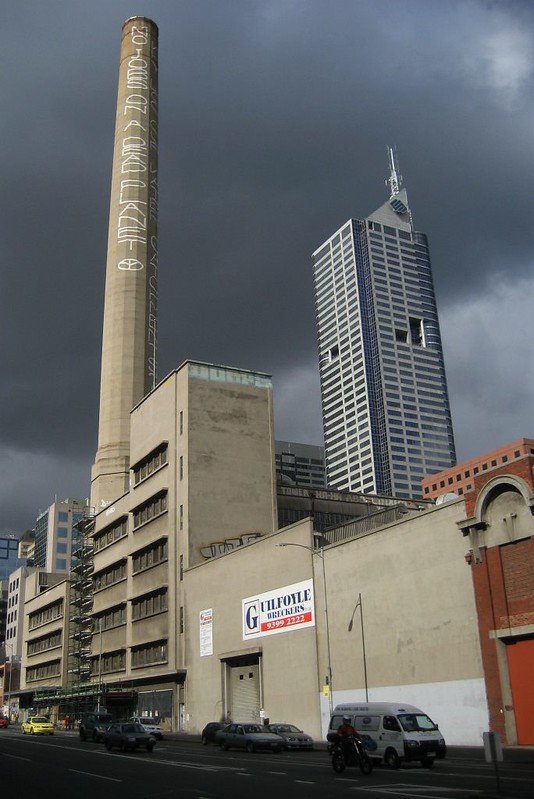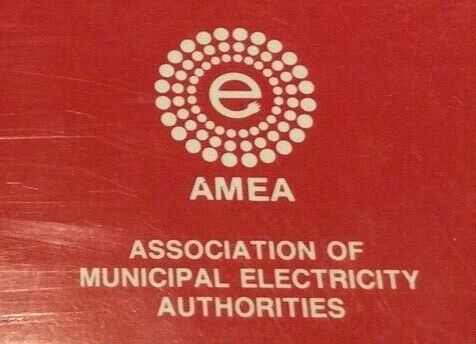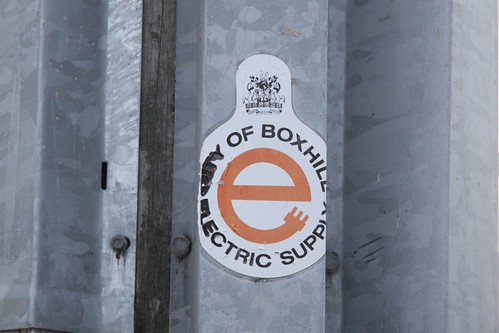Have you ever looked up at a power pole in Melbourne and seen one of these warning signs? They are quite easy to see on older electricity poles that carry high voltage power lines through the streets.
So what do all those letters mean?
- H.V. stands for High Voltage (duh!);
- S.E.C. stands for State Electricity Commission.
The State Electricity Commission of Victoria (SECV) name should ring a bell for many in my audience: until the 1990s they were the monopoly electricity utility in the state of Victoria; operating power stations, maintaining power lines, and sending everyone a power bill every three months.
However, in the streets of Footscray there are some power poles with a slightly different looking sign. So who is this “F.C.C.”? To find out we need to go back to 1896…
Electricity generation in Victoria started out with a wide array of private companies moving into the emerging market of electric light and power. To regulate these companies in 1896 the first Electric Light and Power Act was introduced, and required these companies to obtain an Order-in-Council (O-I-C) to distribute electricity. The Act also said:
- Existing Council or company electricity supply undertakings were automatically entitled to obtain an O-I-C,
- Local Councils were able to take out non time limited O-I-Cs for their areas and could contract out construction and/or operation to other parties,
- Non local government bodies could only obtain O-I-Cs for public supply with the consent of the relevant local Council(s) for no more than 30 years, with the assets being able to be purchased by the Council(s) at the end of that time.
A number of local councils took up the option of taking out an O-I-Cs to operate which became known as Municipal Electricity Undertakings (MEUs), managing electricity distribution and retailing to their ratepayers. The City of Melbourne was the first MEU in 1897, with a key part of their system being the Spencer Street Power Station which supplied the inner city with electricity until the 1960s.
It took 13 years for the next MEU was established, by the City of Footscray in 1910, but by 1915 the number of MEUs had reached 11. The complete list of councils is as follows:
- City of Melbourne (1897)
- City of Footscray (1910)
- City of Brunswick (1912)
- City of Box Hill (1912)
- City of Port Melbourne (1912)
- City of Preston (1912)
- City of Northcote (1913)
- City of Heidelberg (1914)
- City of Coburg (1914)
- City of Doncaster & Templestowe (1914)
- City of Williamstown (1915)
At least that answers who the previously mentioned F.C.C. is – the Footscray City Council.
The other councils to set up MEUs took a different approach to the City of Melbourne, deciding against the expense of setting up their own power stations, and instead purchased electricity in bulk from one of the private companies that already operated a power station. These private companies also operated their own distribution and retail networks in other areas of Melbourne, and in many cases they were also responsible for some of Melbourne’s first electric tramways.
After the early burst of MEU establishments in inner Melbourne, no other councils joined the club, possibly due to a lack of inner-city residents still to be served. The supply of electricity to the rest of state had to wait until the establishment of the State Electricity Commission of Victoria by the government in 1920. Their mission was as follows:
- to inquire into and report to the Government on the measures which should be taken to achieve the ultimate co-ordination and amalgamation of all electrical undertakings in Victoria,
- to supply electricity in bulk to any statutory corporation or undertaking such as municipalities,
- to supply electricity to any person outside any area in which there is an existing undertaking and to Government departments and institutions.
These powers marked the end of the privately owned electricity undertakings, these being acquired by the SECV between 1922 and 1934. For the existing MEUs the only change was their bulk supplier of electricity, but the changes also prevented the formation of any new MEUs – the SECV would supply all other consumers.
This division of responsibilities with MEUs fed by bulk power from the SECV lasted into the 1990s – the JA Zone substation in inner Melbourne was one example of the schism, where the SECV operated the input transformers and switchgear from one control panel, while the Melbourne City Council Electrical Supply Department (MCCESD) managed the output side from a second panel down the hallway.
Eventually accounting for around 15 per cent of the state’s electricity supply, the end of the MEU came in 1994 when the Kennett government launched an extensive reform of the Victorian electricity industry. These changes saw the creation of the 5 electricity distribution companies based on geographic regions, taking over from the monolithic SECV and the 11 MEUs in inner Melbourne.
For their part in the reforms, each of the metropolitan councils entered into an MEU Transfer Agreement with the State of Victoria, and received a share of the profits from the privatisation of the new distribution companies.
Distribution of the funds was slightly complicated by the local government amalgamations carried out a few years before, as the 11 MEUs were now owned by 9 metropolitan councils – the new council LGA names along the left, the old council names in brackets, and the matching distribution company names along the top. Values are in millions of $.
| Council | CitiPower | Solaris (Jemena) | United Energy | Total |
|---|---|---|---|---|
| Melbourne (Melbourne) |
206.9 | – | – | 206.9 |
| Darebin (Northcote, Preston) |
26.5 | 45.7 | – | 72.2 |
| Whitehorse (Box Hill) |
– | – | 62 | 62 |
| Moreland (Brunswick, Coburg) |
26.1 | 24.8 | – | 50.9 |
| Maribyrnong (Footscray) |
– | 45.5 | – | 45.5 |
| Manningham (Doncaster & Templestowe) |
– | – | 33 | 33 |
| Banyule (Heidelberg) |
– | 30.4 | – | 30.4 |
| Port Phillip (Port Melbourne) |
18.1 | – | – | 18.1 |
| Hobsons Bay (Williamstown) |
– | 13.6 | – | 13.6 |
| Total | 277.6 | 160 | 95 | 532.6 |
The transfer agreements were signed in September 1994 and the proceeds were paid to councils between September 1995 and February 1996, this marking the end of Melbourne’s councils involvement in the Victorian electricity industry.
Further reading
- Transfer of Municipal Electricity Undertakings: a report by the Victorian Auditor General, May 1997. Look at page 92 onwards, part of the Report On Ministerial Portfolios.
- Early Electricity Supply in Melbourne: a paper by Miles Pierce detailing the undertakings of the Melbourne City Council along with the competing private operators.
- Victorian Government Gazette, July 3 1961: details all of the O-I-Cs issued in Victoria as of that date.
Footnote: the full list
The full list of Orders-In-Council that established MEUs are as follows, taken from the previously mentioned 1961 Government Gazette:
| Municipality | O-I-C | Date |
|---|---|---|
| City of Melbourne | No. 3-1897 | September 6, 1897 |
| City of Footscray | No. 48-1910 | December 21, 1910 |
| City of Brunswick | No. 73-1912 | April 30, 1912 |
| City of Nunawading | No. 77-1912 | June 20, 1912 |
| City of Preston | No. 68-1912 | October 7, 1912 |
| City of Port Melbourne | No. 82-1912 | October 7, 1912 |
| City of Northcote | No. 80-1913 | January 13, 1913 |
| City of Heidelberg | No. 100-1914 | June 22, 1914 |
| City of Coburg | No. 105-1914 | November 2, 1914 |
| City of Doncaster & Templestowe | No. 108-1914 | December 30, 1914 |
| City of Williamstown | No. 111-1915 | September 14, 1915 |
| City of Doncaster & Templestowe | No. 119-1915 | November 30, 1915 |
| City of Footscray (Werribee) | No. 131-1917 | January 8, 1918 |
| City of Footscray (Braybrook) | No. 136-1918 | May 2, 1918 |
| City of Doncaster & Templestowe | No. 149-1920 | August 10, 1920 |
| City of Footscray (South Kingsville) | No. 275-1952 | June 24, 1952 |
| City of Williamstown (West Newport) | No. 278-1953 | February 24, 1953 |
| City of Box Hill (Burwood) | No. 279-1953 | May 12, 1953 |
| City of Footscray (Kingsville Area) | No. 301-1957 | April 2, 1957 |
Footnote: the ‘Association of Municipal Electricity Authorities’
At one point the ‘Association of Municipal Electricity Authorities’ was formed as a unifying body for the Victorian Municipal Electricity Undertakings – this logo appeared on the 1987 ‘Service & Installation Rules Booklet‘ co-produced with the State Electricity Commission of Victoria.
Note the similarity with the logo of the ‘City of Box Hill Electric Supply’.







And for an update, around Footscray there are a number of substations still bearing the “Footscray City Council Electricity Supply Department” name.
Hi Marcus, glad you found my report and apologies for using a couple of your photos without asking first. Here is an update of it –
https://www.academia.edu/37439697/Maribyrnong_electricity_substations_Heritage_Assessment.
I am looking at a couple of concrete lamp posts in Footscray – Whitehall St either side of Bunbury St and McNab Ave. wondering if you have come across anything about them.
all the best
Gary
I’ve seen those lamp posts before – can see one here:
https://www.google.com/maps/@-37.8031772,144.9050422,3a,19.4y,180.26h,85.47t/data=!3m7!1e1!3m5!1sKQmJdQPpqCo87zoj8Q9wpw!2e0!6s%2F%2Fgeo2.ggpht.com%2Fcbk%3Fpanoid%3DKQmJdQPpqCo87zoj8Q9wpw%26output%3Dthumbnail%26cb_client%3Dmaps_sv.tactile.gps%26thumb%3D2%26w%3D203%26h%3D100%26yaw%3D143.0793%26pitch%3D0%26thumbfov%3D100!7i13312!8i6656
But I’m not sure of their history – maybe dating back to the construction of the Bunbury Street tunnel beneath?
https://wongm.com/2011/10/bulldozing-middle-footscray-then-and-now/
I found the history of the Spencer Street power station very interesting. I worked as an electrician nearby from 1953 until 1970.
But the MCC operated other power systems. Melbourne was originally powered by DC. In March 7, 1894 the Melbourne City Council installed 4 boilers and 20 dynamos on Spencer Street. These provided the DC power to light the streets of the city centre.
The city began converting to an AC network in around 1920 when Yallourn was established. The city maintained a DC network until at least 1970. Because of increasing power demands and problems of pollution, the MCC erected the new chimney and installed Parkinson steam turbines generators My cousin worked on building the chimney stack in the 60’S.
Tesla’s invention of the AC motor had many limitations not the least being the Induction Motor’s limit of speed to below 3000 rpm at 50 hertz, inadequate speed control and poor starting torque.
In fact, the advantage of AC was it could be sourced from where the raw materials for generation were found and transmitted over long distances to the users. Now we know for long distance transmission, DC is more suitable but they never had solid state inverters in those days.
While the MCC compensated owners who owned redundant small motors, it remained cheaper to continue to provide DC for the larger installations. This was provided by banks of Mercury Arc rectifiers situated in Heffernan Lane off Little Bourke Street.
I worked for the PMG and we had a large number of DC Lifts, and at the Chief Telegraph Office, we maintained large variable speed DC Compressors supporting the Telegraph Pneumatic tube System that circulated telegrams, picture grams and information to city Post Offices and newspapers.
The other MCC power system was a 1000 psi reticulated hydraulic system, primarily for the large number of very historic hydraulic lifts still in use in the early 70’s.
Richard Davoren
My great Grandfather, worked as engineer for the M.C.C. electric lighting station in the later 1800s.Would you have any information about this station or him? His name was, James Austin Watkins.
A bit before my time my cousin worked on the the big smokestack and I helped myself to their scrap metal to make foreigners in the PMG workshop over the road.
Myer were still buying MCC DC for their lifts in 1992.
I was responsible for managing the maintenance of the PMG lifts in Melbourne, mostly either old 460 V DC or connected to the hydraulic system. 47 in all. Companies like Otis would not take them on so it was left to the PMG to keep them functioning and the maintenance.
Good day Marcus.
Your article above is very interesting and informative. You obviously know a lot about electricity and its history, so I’m wondering if you know the location of electricity substations in and around Footscray, those old brick ones that are usually in the Art deco style and other architectural styles. I’m doing a photo journal of all the ones I can find. Any thoughts? I have found quite a few in Brunswick, Coburg, East Melbourne, Clifton Hill and Parkville, but I’m not too familiar with the West side of Town.
Regards.
Dimitrios
Hi Dimitrios,
There is one such electricity substation on Cross Street in Footscray, near West Footscray railway station. You can find a history of the structure in this July 2007 report for the City of Maribyrnong by Biosis Research.
The report also includes details of a number of other electricity substations of similar design around Melbourne.
Marcus
Thanks Marcus.
I’ll let you know when my photo-journal is done. Some of the substations are quite interesting in their design and architectural features. There’s more to them than meets the eye.
Dimitrios
[…] More about the Melbourne City Council Electrical Supply Department in an earlier post of mine […]
[…] 1994 residents of the City of Melbourne and ten other municipalities bought their electricity from the local council, not a power […]
[…] Electricity Commission of Victoria. Responsible for the electricity supply to almost of Victoria (more about the sole exception), back in the early 1980s the SECV was in the middle of building the massive Loy Yang power station […]
Hi Marcus
Just today I was wondering about the arrangements under which Port Melbourne supplied its own electricity. Your article is immensely helpful. Thanks for it.
Since you also investigate/document industrial/technical things that may disappear, I would like to draw your attention to the Symex (former Kitchens Factory) in Ingles St, Port Melbourne which has been sold and will likely be redeveloped in the future.
Janet
Hi Marcus,
I’m writing a novel and one of the plotlines calls for an abandonned substation in the Collins street area and I wondered if you could help with a location. The novel is for middle school aged childeren and has a working title of Toby Farrier and the secret of the gold fountain pen. Any help you can ofer will be appreciated.
Russell Place substation might fit the bill:
http://www.whitehat.com.au/Melbourne/Engineering/RPSubStation.asp
At street level is is a nondescript concrete building just off Bourke Street, that leads to a concrete dungeon a few storeys underground.
I’ve got plenty of photos of the inside here:
http://www.flickr.com/photos/legoblock/sets/72157628187403807/
Hi Marcus,
I read your article with interest. I was wondering when electricity in homes became the norm (for middle class people) in Melbourne. Would it be around 1910-15, judging by the MEU dates?
Cheers, Sarah
Museum Victoria points to the creation of the State Electricity Commission in 1921 as a driver for the adoption of domestic electricity use in Melbourne:
https://museumvictoria.com.au/discoverycentre/discovery-centre-news/2009-archive/first-electrical-appliance/
Does anyone have any info on the sub station at 202 A’beckett street in Melbourne.
It looks abandoned and is behind a big red fence. the little sub station is surrounded by skyscrapers on three sides now and is quite an amazing little building architecturally. I really want to know if it is actually still in use or not.
Nice find – the Google Street View imagery from 2009 shows quite a different backdrop:
https://www.google.com.au/maps/@-37.8102484,144.9574423,3a,43.1y,324.34h,82.6t/data=!3m6!1e1!3m4!1stPTAcfKHZf23m6gVLreSQw!2e0!7i13312!8i6656
Going by the warning signs on the fence, it appears the substation is still in use, or was until a few years ago.
The building gets a mention in the Victorian Heritage Inventory (reference H7822-2046) which means the site may be of archeological potential, but the listing doesn’t feature anything else of note:
http://vhd.heritagecouncil.vic.gov.au/places/9959/download-report
I read with interest you very detailed explanation of the history of electricity production and distribution in Victoria. I used to work for the SECV at a most stressing time when it was all split up and sold off by Jeff Kennett to private interests. As a trainee draftsman in the early 80’s I had to learn to deal with some of these old council electricity suppliers like those of MCC, Coburg, Preston etc. until they were integrated into the SECV. You have captured everything I would have known about the history of this era and found this quite interesting.
Glad to hear that you found the article interesting!
[…] For historical reasons the substation was divided into two – the State Electricity Commission of Victoria who generated electricity controlled the 66kV input. […]
Box Hill Electricity Supply was council run and supplied electricity from Koonung Creek in the North, Heatherdale Rd in the East, Warrigal Rd in the west and to Highbury Rd in the south. Their yard was in Oxford St Box Hill with the head office being around the corner in Station St. They moved the yard in the mid 80’s to the old Burwood Drive In Theatre site on Burwood Highway which is now still occupied by the current power supplier. They trained their linesman in Chadstone and ran a 24 hour service restoring power to the area. My mother and us kids used to be the answering team for that service every other week and mum got $11 a week for the pleasure.
Thanks for that – I’ve been past the Burwood yard, and the linesman training yard still looks to be at Chadstone, in what is now Holmesglen TAFE.
[…] (Well, *almost* all of it.) […]
I was employed as an Electrical Engineer by City of Footscray Electricity Supply Department from June 1972 to May 1987. Staff Members in June 1972 included Mr Gallagher Chief Electrical Engineer, Jim Black, Deputy Chief EE, John Johnson Overhead Mains Engineer, myself Nick Wolff Substation Engineer. Jack Molloy – Overhead Mains Superintendent, Peter Audrey Electrical Workshop Foreman, Keith Bromley – Electrical Mechanic Leading Hand and John Hargreaves – Metering Foreman. With Dale Blampied – Drafting Supervisor and Vin Cooney, Colin Philips and Bernie xxx as draftsmen. Many of these have most likely passed away by now (2023) including Peter Audley, (2006) Keith Bromley (2012 approx) and Jim Black (2014) Mr Gallagher has certainly also passed as he retired during my tenure and succeeded by Jim Black, while John Johnson was appointed Deputy Chief EE. Today 3/11/2023 I passed by this part of Melbourne and was reminded of my time working for FCCESD.If anyone reads this post and has knowledge of any former employees and their situation I would be pleased if this information could be added to. Nick Wolff
I worked for Footscray Electricity Supply Department from June 1972 to January 1982 as an Electrical Engineer. If anyone of the situation or whereabouts of staff members form that period I would be pleased to know.
Box Hill Electricity Supply supplied more than just the Box Hill area. They also supplied Nunawading, which at the time was a separate council area. Doncaster Electricity Supply supplied less than the original Shire of Doncaster and Templestowe area, only going as far as the Mullum Mullum Creek. Parts of the shire east of the creek were supplied by the SEC, such as Park Orchards and Warrandyte. I don’t know the history behind these anomalies.
I wonder if the more rural areas were supplied by the SECV because the local council didn’t want to fund an expensive rollout of poles and wires, while the SECV was committed to rural electrification no matter the expense.
That certainly makes sense, given that Park Orchards and beyond was just farmland and well….. orchards.
Another anomaly was the Fairfield/Alphington area, where people paid the City of Heidelberg for their electricity, but paid the City of Northcote for their rates. I believe this stemmed from a ratepayer revolt, where the residents weren’t happy with service from the then Shire of Heidelberg and voted to become part of the City of Northcote. But the poles and wires stayed with Heidelberg Electricity rather than transfer to Northcote Electricity.
Interesting – it was in 1962 that Alphington and Fairfield moved council areas.
https://libraries.darebin.vic.gov.au/darebinheritage/places/suburbs/alphington
This long & little watched video, on the Melb City Council’s power generating operations, may be of interest. https://www.youtube.com/watch?v=MGp58TvDCTU